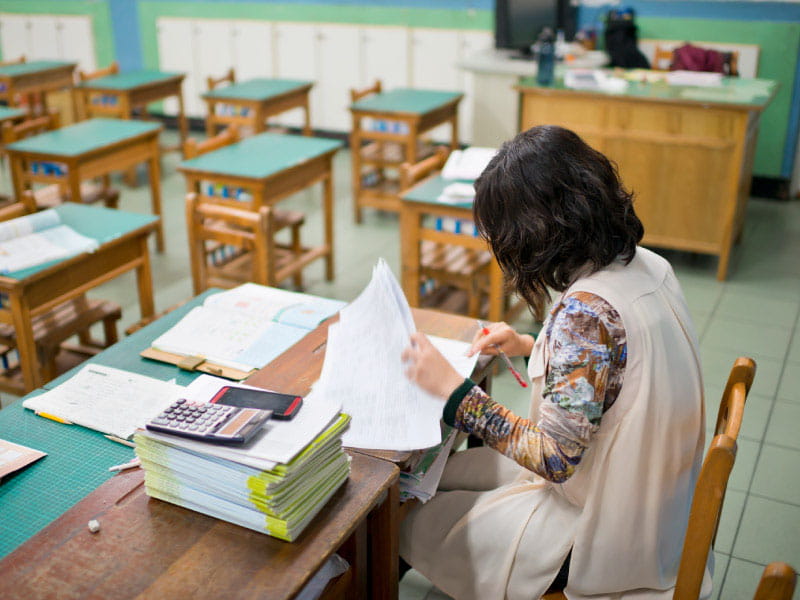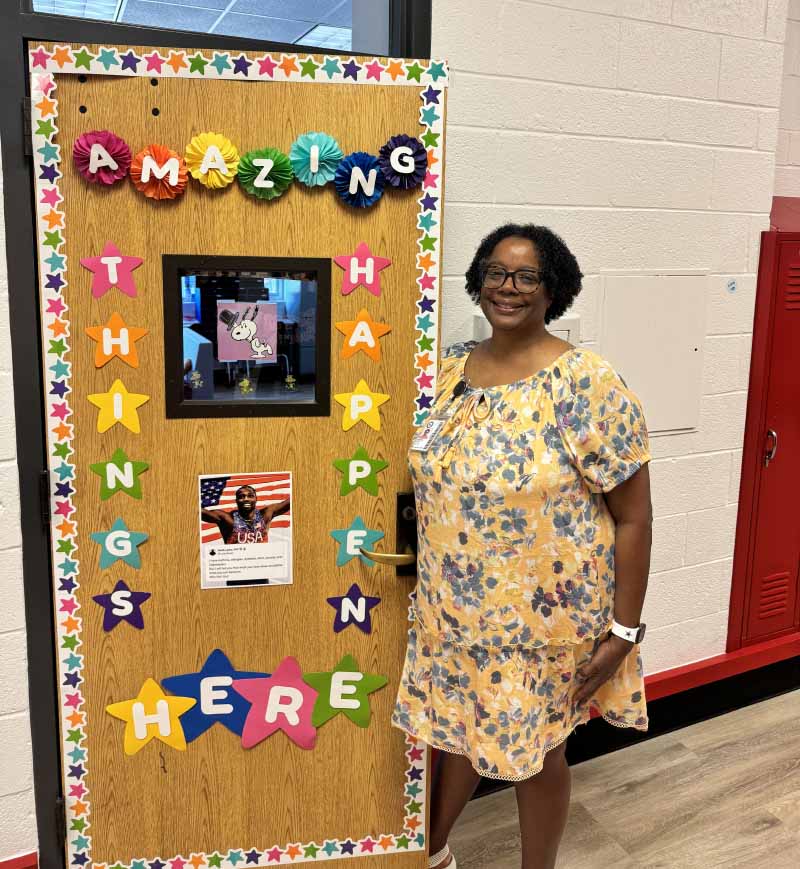Back to school: How teachers can ease their stress
By Michael Merschel, American Heart Association News

If you want to learn about stress, ask a teacher.
"I didn't have high blood pressure or anxiety until I started teaching," Dallas teacher Sheridan Dixon said. But within a few years of beginning a new career as an elementary school teacher in her 40s, she was having panic attacks, and her blood pressure spiked so high that she ended up in an emergency room.
Dixon blames stress. Having worked previously as a special education aide, she was used to classrooms. But her students that first year were tough, she said, and "my body responds to stress by having anxiety attacks."
The demands were overwhelming. "You teach all day long," she said, with perhaps 45 minutes allotted for "plans, copies, papers, reports, meetings, conferences" – everything she needed to do to keep her classroom functioning. How will I get this done, she wondered, without working nights and weekends or buying a copier?
Understanding those and other stresses of teaching can be easy. Dealing with it might be harder, but experts say teachers, administrators and parents all can help.
Any job can be stressful, said Dr. Chris McCarthy, a psychologist in the department of educational psychology at the University of Texas at Austin, where he leads the Coping and Stress in Education Lab. Service professions, including teaching, add the burden of having to be constantly "on" for other people.
Teachers deal with additional factors, he said. They are in charge of large groups of young people, sometimes in schools that lack resources. Many are financially stressed. Meanwhile, the COVID-19 pandemic upended the education world, and teachers have found themselves in political and cultural crosshairs as well.
"I think when you look at all of those things, you'd say, 'Why wouldn't teachers be stressed?'" McCarthy said.
Stress is associated with health problems such as high blood pressure and heart rhythm issues. Not everybody responds the same. "Teachers all have different abilities and skill sets and personalities and home lives," he said, and reactions can vary.
But when a teacher is under stress, the effects can spill into the classroom and hurt student achievement. Dr. Lauren Davis, an associate professor and department head of education at Montana State University in Bozeman, said students can see that stress, and some will start feeling unsafe or push limits to provoke a reaction. "A teacher who is tired and has no bandwidth left gets angry with students, and then it becomes this power struggle."
A national survey by RAND, a nonprofit research organization, released in June found that compared with other working adults, about twice as many teachers reported frequent job-related stress or burnout, and roughly three times as many teachers reported difficulty coping with job-related stress. Female teachers reported higher rates of job-related stress than male teachers.
Davis and McCarthy offered this advice on addressing stress.
For teachers
Telling teachers to find time to take care of themselves can be easier said than done, McCarthy acknowledged. "Teachers barely have time to eat lunch or go to the bathroom, much less do some of this stuff."
He started with "the real obvious self-care kinds of things," such as exercise and a healthy diet. And while that advice is "not all that magical," busy teachers often don't prioritize such basics.
But the investment can pay off. Davis, for example, has done research showing the benefits of making time for yoga sessions outside of the workday. In addition to well-established health benefits of yoga, teachers can learn breathing techniques to help them stay calm all day. Preliminary research, she said, suggests that students also are calmer when their teachers practice the techniques they've learned.
McCarthy sometimes begins his graduate-level classes with a three-minute awareness activity, such as breathing or drawing. The techniques would differ for younger students, but "things like that can be done super quick," he said.
He and Davis both draw on the concepts of trauma-informed care, which seeks to recognize stressors in a student's life. Learning to see students' behaviors as products of their own backgrounds, and not necessarily personal, can help a teacher respond in a caring and supportive way, McCarthy said.
Teachers also need to set healthy boundaries, said Davis, who has worked both as a middle school teacher and an assistant principal in North Carolina.
"Teachers are often up late grading, or they get up early to grade," she said. They often practice "revenge procrastination," where they feel the only period of time available for themselves is at night. "So they're going to put off going to bed as long as they can because they just want to watch their TV show – and I don't blame them because I did that myself."
Proper sleep has been associated with lower stress levels. It's also considered essential to heart health.
Davis also would regularly stay late and work weekends. But working seven days a week, 12 hours a day is a recipe for burnout, she said.
She recommends teachers make sure they leave on time, decline to answer emails on the weekend, or not respond to parents after certain hours. Whatever those rules are, stick to them, Davis said, "because otherwise you're just going to be Swiss cheese at the end of the day."
For school leaders
"In a perfect world, there would be more financial support of schools, where we could employ more teachers and reduce class sizes and provide more planning time and more support personnel," Davis said.
Principals often are stuck in the middle, between superintendent demands and teacher needs. But they can help, McCarthy and Davis said, by balancing workloads – for example, by not always giving new teachers the least-wanted assignments, or by making sure teachers aren't overworking themselves.
Restrictive systems strain teachers, McCarthy said. Most teachers go through rigorous training, so it can be counterproductive when they find themselves in schools where they have no autonomy or are micromanaged.
Ensuring that young teachers learn trauma-informed care principles early in their training is important, McCarthy said. Stress-related problems can take root early. "Student-teachers enter with a lot of idealism and enthusiasm," he said. "And it's like a real gut punch sometimes when they get into schools."
Not every change has to be systemic.
"Teachers deserve their own space to just have a quiet moment to reset themselves," Davis said. Some schools have turned unused rooms into spaces where teachers can relax. "It's like a teacher timeout room, where it's very quiet, there's soft music, soft lighting. Maybe there's a recliner. Maybe there's a massage chair."
Davis said when she was an assistant principal, her nearly 1,000-student school had no such space. So she shared her own. "I joke that my office was the place where people came to cry," she said. She would offer her office to teachers as a place of privacy and leave to do classroom checks, while teachers took the time they needed.
"I think people just need space to just have a minute to breathe and cry if they need to," she said. "And then they can move on with their day."
For parents
Teacher appreciation is important, McCarthy said. But the approach matters.
Based on research one of his students did on a small group of teachers in a suburban Texas district, "teachers really appreciate when they get individual and specific feedback" from students, parents or community members.
Generic Teacher Appreciation Day activities, "where everybody brings in cookies or something like that," didn't do much, he said.
Davis recalled a year when parents provided teachers with a nice lunch – except teachers weren't relieved from their regular duties to enjoy it. Another time, at the school where she was an administrator, parents actually came in to watch classrooms, giving teachers a real break.
Teachers also can be deeply appreciative of affordable but practical gifts that would be seen as "breadcrumbs" in corporate settings, Davis said. As part of her research, for example, teachers were given yoga equipment, including a blanket and a mat. "Some of these teachers welled up with tears, and they were like, 'I get to keep this?'" she recalled. "It was like Christmas for them."
Dixon, the Dallas teacher, found her own way to solve her stressful situation. In addition to medication for her blood pressure and anxiety, she re-evaluated her career.
After many years teaching several elementary grades, Dixon decided she would do better if she focused on a few students who needed her the most. She decided to transition to work as a reading specialist, which has a more focused curriculum and lets her work with smaller groups of students.

The work is challenging, she said, but her stress level is much lower.
Dixon, now 55, said she strives to be productive while also setting boundaries. "I'm going to do the best that I can and get stuff done as promptly as I can," she said. "But I'm not going stress and hurt my body."
That only makes sense, she said. "If you can't take care of yourself, then you're not going be able to give your best to everyone else."





